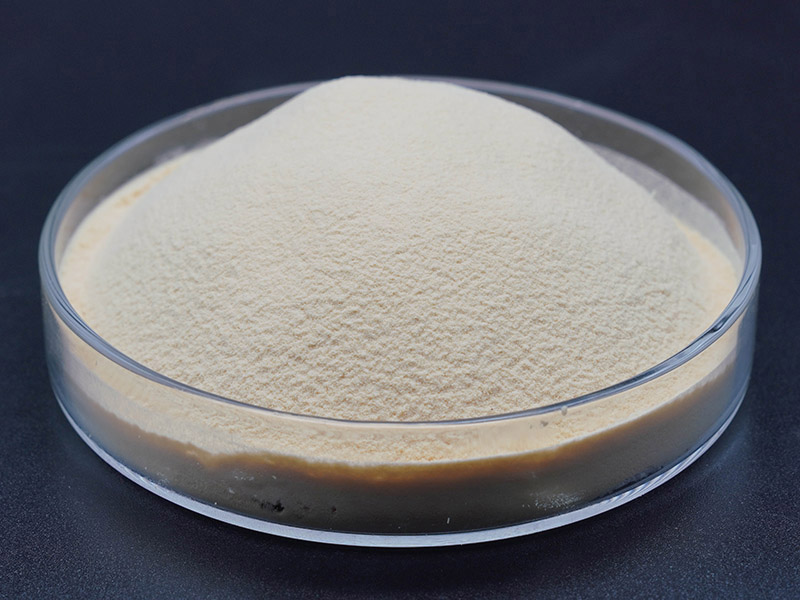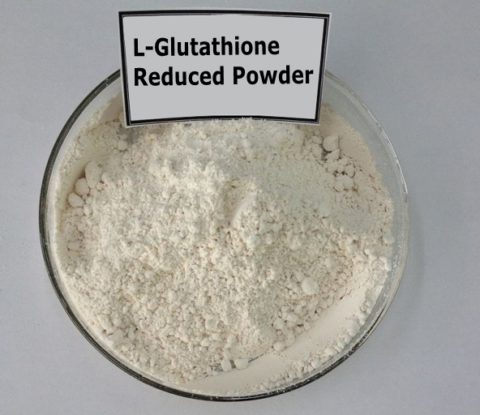
L-Glutathione Enriched Yeast Extract Powder 8%, 15%, 30%, 50% HPLC
L-glutathione enriched yeast extract powder contains glutathione, amino acids, flavored nucleotides, B vitamins and microelements. At the same time, it combines the efficacy of glutathione and the advantages of yeast extract.
L-Glutathione Enriched Yeast Extract Powder 8%, 15%, 30%, 50% HPLC
【CAS No.】: L-Glutathione 8%, 15%, 30%, 50% HPLC
【CAS No.】: 70-18-8
【Einecs No.】: 200-725-4
【Molecular weight】: 162.273
【Melecular Formula】: C10H17N3O6S
【Appearance】: Light yellow to offwhite fine powder
【Application】:L-Glutathione Enriched Yeast Extracts is rich in glutathione, which can antioxidant, scavenging free radicals, detoxification, enhances immunity, anti-aging. It is completely natural and safe, widely used in masks, creams and oral liquids.
【Packing】: Packed in 25 kg/fiber drum with double plastic bags inside
【Storage】: Store in a cool&dry place away from Moisture, Light, Oxygen
【Shelf Life】: 24 months since the manufacturing date

L-Glutathione Reduced (GSH) is a tripeptide which consists of glutamic acid, cysteine, and glycin. And it comprises a major portion of cellular nonprotein thiols, plays a central role in a diverse group of cell metabolic functions. Glutathione is soluble in water, dil alcohol, liq ammonia, dimethylformamide, not in grain alcohol, aether and acetone. Its solid is relative stable. And its solution is easily oxidized in the air. Two molecules also the lively reduced glutathione-condensation of the disulfide bonds, are oxidized glutathione (GSSG). Glutathione is widely applied to food, pharmaceutical, cosmetic and other fields. Yeast extract L-Glutathione via microbe fermentation, separation,purification and other modern bioengineering techniques.
Difference between Glutathione Reduced (GSH) and Oxidized (GSSG)
Glutathione is a protein made from three amino acids: glutamate, cysteine and glycine. It is a powerful antioxidant formed in the liver, and it supports a wide variety of immune functions throughout the body. Glutathione can exist as one of two different forms: glutathione and L-glutathione.
L-glutathione also is known as reduced glutathione, or GSH, and is composed of a single glutathione molecule with the addition of a sulfhydryl group. When the sulfhydryl groups of two reduced glutathione molecules become oxidized through the loss of electrons, the two molecules can become linked by a disulphide bond and form oxidized glutathione, or GSSG. Oxidized glutathione then is cycled back into reduced glutathione by the glutathione reductase enzyme.
Reduced glutathione is the active form. It donates electrons to free radicals, or molecules with unpaired electrons. The addition of donated electrons neutralizes the free radicals and prevents them from causing cellular damage. Glutathione also participates in various other cellular processes, such as acting as a co-enzyme in biological reactions.
Benefits of Glutathione
Glutathione exists in both reduced (GSH) and oxidized (GSSG) states. In the reduced state, the thiol group of cysteine is able to donate a reducing equivalent (H++ e−) to other molecules, such as reactive oxygen species to neutralize them, or to protein cysteines to maintain their reduced forms. With donating an electron, glutathione itself becomes reactive and readily reacts with another reactive glutathione to form glutathione disulfide (GSSG). Such a reaction is probable due to the relatively high concentration of glutathione in cells (up to 7 mM in the liver).[1]
Generally, interactions between GSH and other molecules with higher relative electrophilicity deplete GSH levels within the cell. An exception to this case involves the sensitivity of GSH to the electrophilic compound’s relative concentration. In high concentrations, the organic molecule Diethyl maleate fully depleted GSH levels in cells. However, in low concentrations, a minor decrease in cellular GSH levels was followed by a two-fold increase.[2][3]
GSH can be regenerated from GSSG by the enzyme glutathione reductase (GSR):[3] NADPH reduces FAD present in GSR to produce a transient FADH-anion. This anion then quickly breaks a disulfide bond (Cys58 – Cys63) and leads to Cys63’s nucleophilically attacking the nearest sulfide unit in the GSSG molecule (promoted by His467), which creates a mixed disulfide bond (GS-Cys58) and a GS-anion. His467 of GSR then protonates the GS-anion to form the first GSH. Next, Cys63 nucleophilically attacks the sulfide of Cys58, releasing a GS-anion, which, in turn, picks up a solvent proton and is released from the enzyme, thereby creating the second GSH. So, for every GSSG and NADPH, two reduced GSH molecules are gained, which can again act as antioxidants scavenging reactive oxygen species in the cell.
In healthy cells and tissue, more than 90% of the total glutathione pool is in the reduced form (GSH) and less than 10% exists in the disulfide form (GSSG). An increased GSSG-to-GSH ratio is considered indicative of oxidative stress.[4]
Glutathione has multiple functions:
1). It maintains levels of reduced glutaredoxin and glutathione peroxidase[5]
2). It is one of the major endogenous antioxidants produced by the cells, participating directly in the neutralization of free radicals and reactive oxygen compounds, as well as maintaining exogenous antioxidants such as vitamins C and E in their reduced (active) forms.[6][7][8]
3). Regulation of the nitric oxide cycle is critical for life, but can be problematic if unregulated.[9]
4). It is used in metabolic and biochemical reactions such as DNA synthesis and repair, protein synthesis, prostaglandin synthesis, amino acid transport, and enzyme activation. Thus, every system in the body can be affected by the state of the glutathione system, especially the immune system, the nervous system, the gastrointestinal system, and the lungs.
5). It has a vital function in iron metabolism. Yeast cells depleted of GSH or containing toxic levels of GSH show an intense iron starvation-like response and impairment of the activity of extramitochondrial ISC enzymes thus inhibiting oxidative endoplasmic reticulum folding, followed by death.[10]
6). It has roles in progression of the cell cycle, including cell death. GSH levels regulate redox changes to nuclear proteins necessary for the initiation of cell differentiation. Differences in GSH levels also determine the expressed mode of cell death, being either apoptosis or cell necrosis. Manageably low levels result in the systematic breakage of the cell whereas excessively low levels result in rapid cell death.[11]
Application of L-Glutathione Reduced GSH
Glutathione role of clinical treatment and prevention
Under pathological conditions when endogenous GSH reduction, timely exogenous GSH has become to be. Exogenous GSH supplement can prevent and treat related diseases, maintain a healthy body.
1). radiation sickness and radiation safety: radiation, radioactive substances or because of leukopenia caused by anticancer drugs and other symptoms can play a protective effect.
2). to protect the liver, detoxification, inactivation of hormones, and to promote bile acid metabolism and help absorb fat and fat-soluble vitamins digestive tract.
3). anti-allergy, or inflammation caused by hypoxemia in patients with systemic or local, can reduce cell damage and promote repair.
4). to improve the course of certain diseases and symptoms as adjuvant drugs. Such as: hepatitis, hemolytic disease, and keratitis, cataract and retinal diseases, such as eye disease and improve vision.
5). easy to speed up the metabolism of acids in the excretion of free radicals, which play a beauty skin care, anti-aging effect.
Food additives
1). added to pasta, to make manufacturers reduce the time of bread to the original one-half or one third, and serve to strengthen the role of food nutrition and other features.
2). to add to the yogurt and baby food, the equivalent of vitamin C, can play a stabilizing agent.
3). in its mix to the surimi to prevent color deepened.
4). to the meat and cheese and other foods, have enhanced the effect of flavor.
Beauty products
Prevent the infiltration of Los tyrosinase in order to achieve the purpose of inhibiting melanin formation. On eliminate wrinkles, increase skin elasticity, shrink pores, lighten pigment, the body has an excellent whitening effect.
Glutathione as the main ingredient in cosmetic products in Europe and the United States was welcomed by the decades.
Reference:
1. Kaplowitz, N. (1981-01-01). “The importance and regulation of hepatic glutathione.”. The Yale Journal of Biology and Medicine. 54 (6): 497–502. ISSN 0044-0086. PMC 2596047 . PMID 7342494.
2. Jump up^ Bannai, Shiro; Tateishi, Noriko (1986-02-01). “Role of membrane transport in metabolism and function of glutathione in mammals”. The Journal of Membrane Biology. 89 (1): 1–8. doi:10.1007/BF01870891.ISSN 0022-2631.
3. Jump up^ Bannai, S. (1984-02-25). “Induction of cystine and glutamate transport activity in human fibroblasts by diethyl maleate and other electrophilic agents”. The Journal of Biological Chemistry. 259 (4): 2435–2440.ISSN 0021-9258. PMID 6142042.
4. Jump up^ Halprin, Kenneth (1967). “The Measurement of Glutathione in Human Epidermis using Glutathione Reductase”. Journal of Investigative Dermatology. 48 (2): 149. doi:10.1038/jid.1967.24.
5. Jump up^ Grant, Chris M. (2001-02-01). “Role of the glutathione/glutaredoxin and thioredoxin systems in yeast growth and response to stress conditions”.Molecular Microbiology. 39 (3): 533–541. doi:10.1046/j.1365-2958.2001.02283.x. ISSN 1365-2958.
6. Jump up^ Dringen, R. (2000-12-01). “Metabolism and functions of glutathione in brain”. Progress in Neurobiology. 62 (6): 649–671. doi:10.1016/s0301-0082(99)00060-x. ISSN 0301-0082. PMID 10880854.
7. Jump up^ Scholz, RW. Graham KS. Gumpricht E. Reddy CC. (1989). “Mechanism of interaction of vitamin E and glutathione in the protection against membrane lipid peroxidation”. Ann NY Acad Sci. 570: 514–7.doi:10.1111/j.1749-6632.1989.tb14973.x.
8. Jump up^ Hughes, RE (1964). “Reduction of dehydroascorbic acid by animal tissues”. Nature. 203 (4949): 1068–9. doi:10.1038/2031068a0.
9. Jump up^ Clementi, Emilio; Smith, Guy Charles; Howden, Martin; Dietrich, Salvador; Bugg, S; O’Connell, MJ; Goldsbrough, PB; Cobbett, CS (1999).”Phytochelatin synthase genes from Arabidopsis and the yeastSchizosaccharomyces pombe”. The Plant cell. 11 (6): 1153–64.doi:10.1105/tpc.11.6.1153. JSTOR 3870806. PMC 144235 .PMID 10368185.
10. Jump up^ Kumar, Chitranshu; et al. (2011). “Glutathione revisited: a vital function in iron metabolism and ancillary role in thiol-redox control”.The EMBO Journal. 30: 2044–2056. doi:10.1038/emboj.2011.105.PMC 3098478 . PMID 21478822.
11. Jump up^ Hall, A. G. (1999-03-01). “Review: The role of glutathione in the regulation of apoptosis”. European Journal of Clinical Investigation. 29(3): 238–245. doi:10.1046/j.1365-2362.1999.00447.x. ISSN 0014-2972.PMID 10202381.

